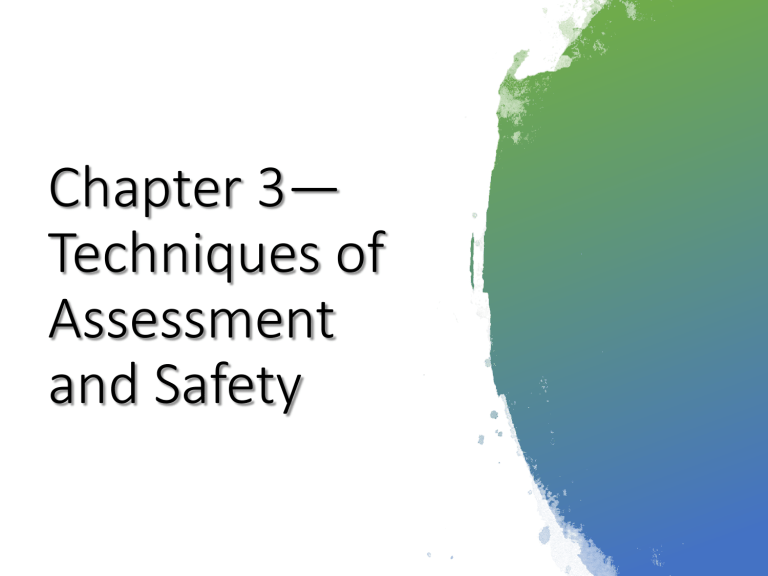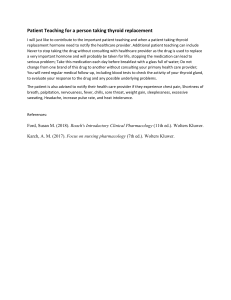
Chapter 3— Techniques of Assessment and Safety Copyright Copyright © 2015 Wolters © 2019 Wolters Kluwer Health Kluwer| •Lippincott All RightsWilliams Reserved & Wilkins Four Physical Assessment Techniques Inspection: observing patient visually for general appearance or specific details Palpation: clinical touching of specific body areas to assess characteristics Percussion: tapping technique with hands to determine condition of solid or air-filled body areas Auscultation: using a stethoscope to assessment movement of air or fluid within specific body systems Copyright © 2019 Wolters Kluwer • All Rights Reserved Hand hygiene Precautions to Prevent Infection #1 • Most important transmission prevention strategy • Five sequential steps for patient-to-patient pathogen transmission • WHO recommended implementation Glove use • When to wear gloves • When to change gloves • Glove removal Copyright © 2019 Wolters Kluwer • All Rights Reserved Standard precautions Precautions to Prevent Infection #2 • Purpose: prevent disease transmission during contact with nonintact skin, mucous membranes, body substances, and bloodborne contacts • Respiratory hygiene/cough etiquette strategies Latex allergy • Prevention: avoid contact whenever possible Skin reactions • Minimize hand eczema via alcoholbased hand rubs Copyright © 2019 Wolters Kluwer • All Rights Reserved Purpose: provides objective physical data leading to accurate diagnoses and treatment Consciously observing patients, gathering data Only technique used for every body part, system Inspection #1 Overall observation = general survey Adequate exposure of each body part is necessary, maintaining modesty is very important. Devices may limit visibility: Adjust device to facilitate complete inspection. Accurate documentation of findings are important for communication; are legally binding Note if data is consistent; identify patterns or clusters. Copyright © 2019 Wolters Kluwer • All Rights Reserved Inspection #2 • Characteristics for inspection • Physical characteristics; odors • Behaviors • Age; gender • Level of alertness • Body size, shape • Skin color • Hygiene • Posture • Level of comfort/anxiety Copyright © 2019 Wolters Kluwer • All Rights Reserved Palpation #1 • Purpose: patient physical assessment using touch for various characteristics of skin, other organs • Texture; temperature; moisture; size; shape • Location; position; vibration; crepitus; tenderness • Pain; edema • Finger pads: fine discrimination • Pulses, small lumps; skin texture, edema • Finger palmar surfaces, finger joints • Firmness, contour, position, size, pain, tenderness Copyright © 2019 Wolters Kluwer • All Rights Reserved Palpation #2 Hand Light palpation (1 cm): begin with Moderate (1 to 2 cm) Palm: abdominal assessment Appropriate for surface characteristics Assess abdominal organ characteristics Dorsal surface of hand: temperature Use pressure from both hands, palmar surface of fingers. Copyright © 2019 Wolters Kluwer • All Rights Reserved Purpose: produce sound or elicit tenderness Conducted sounds via Percussion #1 • Dense tissue: quiet tones • Quietest over bones • Air, fluid: louder tones • Loudest over lungs, hollow stomach Direct percussion: Tap fingers directly on skin Indirect percussion: Use nondominant hand as barrier on which to strongly tap Copyright © 2019 Wolters Kluwer • All Rights Reserved Percussion tones • Flat; dull • Resonant; tympanic Percussion sounds Percussion #2 • Intensity or loudness: volume of sound • Pitch or frequency: vibration oscillation speed • Duration: length of time sound lasts • Quality: subjective description of sound Copyright © 2019 Wolters Kluwer • All Rights Reserved Auscultation #1 • Purpose: listening for body sounds, typically from organs and tissues, to assess function • Common foci • Blood pressure; lungs • Heart; abdomen • Descriptors • Intensity; pitch • Duration; quality • Crackles Copyright © 2019 Wolters Kluwer • All Rights Reserved Auscultation #2 Stethoscope Parts Conducts (does not amplify) sound Ear tips Blocks environmental noise • Differing sizes, firmness Earpiece: tilted slightly forward Flexible tubing: 21 to 27 in. Chest piece: diaphragm, bell (some varieties) Copyright © 2019 Wolters Kluwer • All Rights Reserved Auscultation #3 Stethoscope Diaphragm Bell Light contact to hear lowfrequency sounds Used for most sounds Low-pitched sounds • Heart and lungs • Heart sounds Firm contact to hear highfrequency sounds Copyright © 2019 Wolters Kluwer • All Rights Reserved Auscultation #4 • Stethoscope • Disinfect between patients • Made direct contact with skin • Avoid listening over clothing • Place the endpiece between the index and the middle fingers, not on top of the stethoscope • Moisten body hair to avoid crackly noise as hair and stethoscope make contact. Copyright © 2019 Wolters Kluwer • All Rights Reserved Equipment for a Complete Physical Assessment Gather all equipment. Appropriate equipment depends on the type of examination. General assessment: hospital setting Vital signs equipment • Thermometer; alcohol; blood pressure cuff or machine; watch with second hand; stethoscope Scale; flashlight Materials for recording findings Copyright © 2019 Wolters Kluwer • All Rights Reserved Documenting Findings Inspection Palpation Percussion Auscultation Visualization of general appearance Assessing condition via sense of touch Tapping to assess condition of hollow or fluid-filled spaces Listening to assess organ and tissue condition Copyright © 2019 Wolters Kluwer • All Rights Reserved Question #1 • Palpation is the assessment of the patient through touch. What is light palpation appropriate for? A. Assessment of the size, shape, and consistency of abdominal organs B. Assessment of any guarding, grimacing, or tension C. Assessment of inflamed areas of skin D. Assessment of 2 to 4 cm below body surface Copyright © 2019 Wolters Kluwer • All Rights Reserved Answer to Question #1 • C. Assessment of inflamed areas of skin Rationale: Light palpation is appropriate for the assessment of surface characteristics, such as texture, surface lesions or lumps, or inflamed areas of skin (e.g., over an intravenous site). Copyright © 2019 Wolters Kluwer • All Rights Reserved









